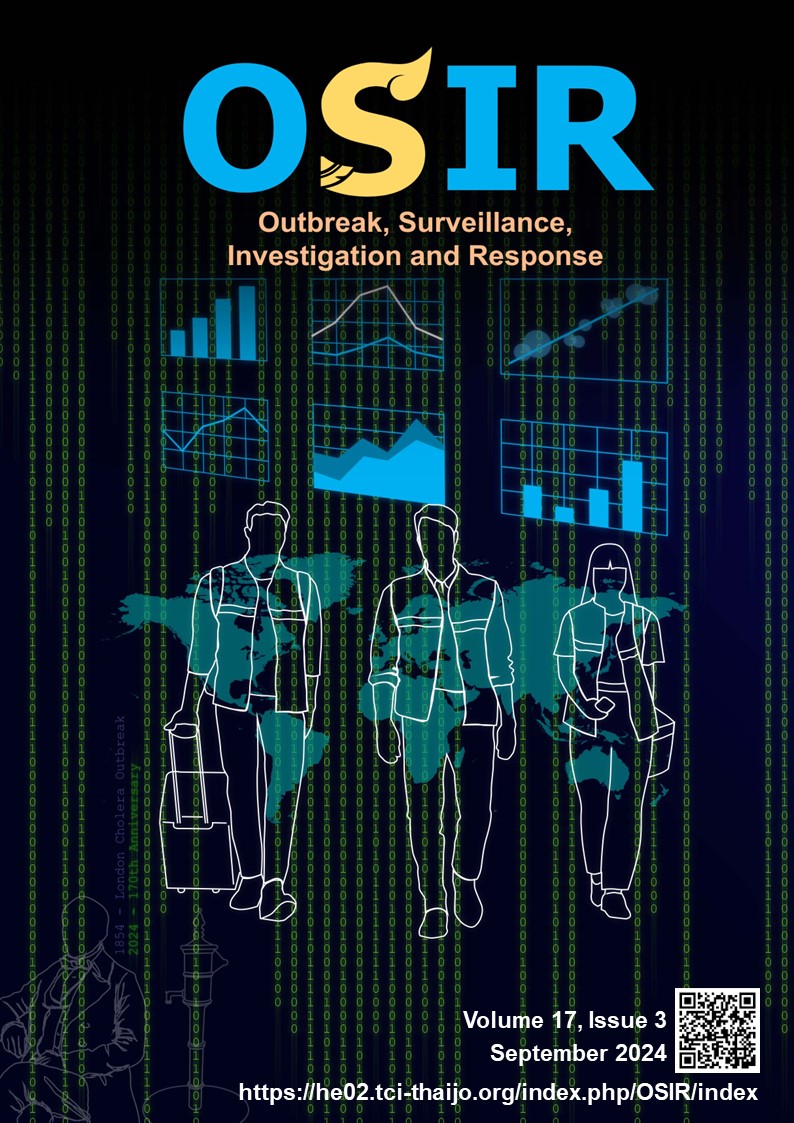Predicting Factors for Malaria Reintroduction and A Multi-factorial Approach to Prevent Malaria Outbreaks in the Malaria-free Areas
DOI:
https://doi.org/10.59096/osir.v17i3.269365Keywords:
malaria, reintroduction, sustained local transmission, elimination, ThailandAbstract
Thailand’s National Malaria Elimination Strategy, 2017–2026, aims to reach zero indigenous transmission by 2024. During 2016–2021, Thailand had successfully reduced its malaria burden by more than 80%. However, a resurgence of malaria in 2022 saw an increase in the incidence in 33 provinces. To identify the predictors of malaria epidemic re-occurring in malaria-free areas, secondary data of malaria-reintroduced villages in 2022 were obtained from the Malaria Information System. A descriptive cross-sectional study was conducted to compare characteristics, prevention, and response measures between villages with and without sustained local transmission after malaria reintroduction. A retrospective cohort study was conducted to determine the associations between sustained local transmission and potential predictors. Among the transmission foci in 2022, 336 villages had previously been malaria-free, of which 73 (21.7%) reported sustained local transmission. A multi-level logistic regression model, considering villages clustered within provinces, found that villages located in a district which contained active foci (adjusted odds ratio (AOR) 1.03, 95% confidence interval (CI) 1.01–1.05) and having a higher proportion of non-Thai cases (AOR 12.3, 95% CI 5.69–26.6) were significantly associated with sustained local transmission whereas coverage of malaria control within 7 days was protective (AOR 0.20, 95% CI 0.09–0.44). Areas with high migrant populations were associated with a higher risk of malaria reintroduction. Proactive case search should target these populations to quickly detect reintroduced cases and conduct timely control to prevent further local transmission.
References
World Health Organization. World malaria report 2022 [Internet]. Geneva: World Health Organization; 2022 [cited 2024 Mar 16]. <https://www.who.int/teams/global-malaria-programme/reports/world-malaria-report-2022>
World Health Organization. Global technical strategy for malaria 2016–2030, 2021 update [Internet]. Geneva: World Health Organization; 2021 [cited 2024 Mar 16]. <https://www.who.int/publications/i/item/9789240031357>
Ministry of Public Health (TH). Thailand national malaria elimination strategy (2017–2026); Malaria Elimination Operational Plan (2017–2021) [Internet]. Singapore: Asia Pacific Malaria Elimination Network; 2015 [cited 2024 Mar 16]. <https://apmen.org/resources/thailand-national-malaria-elimination-strategy-2017-2026-malaria-elimination-operational>
Department of Disease Control (TH). Malaria information system [Internet]. Nonthaburi: Department of Disease Control, Ministry of Public Health; 2024 [cited 2024 Mar 16]. <https://malaria.ddc.moph.go.th/malariar10>
Bisanzio D, Sudathip P, Kitchakarn S, Kanjanasuwan J, Gopinath D, Pinyajeerapat N, et al. Malaria stratification mapping in Thailand to support prevention of reestablishment. Am J Trop Med Hyg. 2023 Dec 11;110(1):79–82. doi:10.4269/ajtmh.23-0595.
U.S. President’s Malaria Initiative. Thailand malaria profile [Internet]. Herndon (VA): U.S. President’s Malaria Initiative; 2023 Aug 4 [cited 2024 Mar 16]. 13 p. <https://d1u4sg1s9ptc4z.cloudfront.net/uploads/2023/12/FY-2024-Thailand-Country-Malaria-Profile.pdf.>
Lertpiriyasuwat C, Sudathip P, Kitchakarn S, Areechokchai D, Naowarat S, Shah JA, et al. Implementation and success factors from Thailand’s 1-3-7 surveillance strategy for malaria elimination. Malar J. 2021 Apr 27;20(1):201. doi:10.1186/s12936-021-03740-z.
Office of Public Health Data, Surveillance, and Technology. Epi infoTM [Internet]. Atlanta: Centers for Disease Control and Prevention (US); 2022 Sep 16 [cited 2024 Apr 2]. <https://www.cdc.gov/epiinfo>
R Core Team. R: a language and environment for statistical computing [Internet]. Vienna: R Foundation; 2012 [cited 2024 Apr 20]. <https://www.R-project.org>
United Nations High Commissioner for Refugees. 2024: refugee preparedness and response plan, Thai-Myanmar border [Internet]. Geneva: Operational Data Portal, United Nations High Commissioner for Refugees; 2024 Apr 3 [cited 2024 May 14]. <https://reporting.unhcr.org/thailand-myanmar-border-refugee-preparedness-and-response-plan>
International Organization for Migration. Migration Context [Internet]. Geneva: International Organization for Migration; [cited 2024 May 14]. <https://thailand.iom.int/migration-context>
Yukich JO, Lindblade K, Kolaczinski J. Receptivity to malaria: meaning and measurement. Malar J. 2022 May 8;21(1):145. doi:10.1186/s12936-022-04155-0.
Asia Pacific Malaria Elimination Network. Preventing malaria reintroduction: strategies for targeting mobile and migrant populations [Internet]. Singapore: Asia Pacific Malaria Elimination Network; 2024 Apr 1 [cited 2024 May 17]. <https://apmen.org/blog/preventing-malaria-reintroduction-strategies-targeting-mobile-and-migrant-populations>
Kheang ST, Lin MA, Lwin S, Naing YH, Yarzar P, Kak N, et al. Malaria case detection among mobile populations and migrant workers in Myanmar: comparison of 3 service delivery approaches. Glob Health Sci Pract. 2018 Jun 29;6(2):384–9. doi:10.9745/GHSP-D-17-00318.
Adams MW, Sutherland EG, Eckert EL, Saalim K, Reithinger R. Leaving no one behind: targeting mobile and migrant populations with health interventions for disease elimination-a descriptive systematic review. BMC Med. 2022 May 9;20(1):172. doi:10.1186/s12916-022-02365-6.
Wang D, Li S, Cheng Z, Xiao N, Cotter C, Hwang J, et al. Transmission risk from imported Plasmodium vivax Malaria in the China–Myanmar border region. Emerg Infect Dis. 2015 Oct 20;21(10):1861–4. doi:10.3201/eid2110.150679.
Schapira A, Kondrashin A. Prevention of re-establishment of malaria. Malar J. 2021 May 31;20(1):243. doi:10.1186/s12936-021-03781-4.
Ranjbar M, Shoghli A, Kolifarhood G, Tabatabaei SM, Amlashi M, Mohammadi M. Predicting factors for malaria re-introduction: an applied model in an elimination setting to prevent malaria outbreaks. Malar J. 2016 Mar 2;15:138. doi:10.1186/s12936-016-1192-y.
Taylor WRJ, Thriemer K, von Seidlein L, Yuentrakul P, Assawariyathipat T, Assefa A, et al. Short-course primaquine for the radical cure of Plasmodium vivax malaria: a multicentre, randomised, placebo-controlled non-inferiority trial. Lancet. 2019 Sep 14;394(10202):929–38. doi:10.1016/S0140-6736(19)31285-1.
Chamma-Siqueira NN, Negreiros SC, Ballard SB, Farias S, Silva SP, Chenet SM, et al. Higher-dose primaquine to prevent relapse of Plasmodium vivax malaria. N Engl J Med. 2022 Mar 31;386(13):1244–53. doi:10.1056/NEJMoa2104226.
Velez ID, Hien TT, Green JA, Martin A, Sharma H, Rousell VM, et al. Tafenoquine exposure assessment, safety, and relapse prevention efficacy in children with Plasmodium vivax malaria: open-label, single-arm, non-comparative, multicentre, pharmacokinetic bridging, phase 2 trial. Lancet Child Adolesc Health. 2022 Feb;6(2):86–95. doi:10.1016/S2352-4642(21)00328-X.
Llanos-Cuentas A, Manrrique P, Rosas-Aguirre A, Herrera S, Hsiang MS. Tafenoquine for the treatment of Plasmodium vivax malaria. Expert Opin Pharmacother. 2022 Apr 13;23(7):759–68. doi:10.1080/14656566.2022.2058394.
Downloads
Published
How to Cite
Issue
Section
License
Copyright (c) 2024 Outbreak, Surveillance, Investigation & Response (OSIR) Journal

This work is licensed under a Creative Commons Attribution-NonCommercial-NoDerivatives 4.0 International License.









